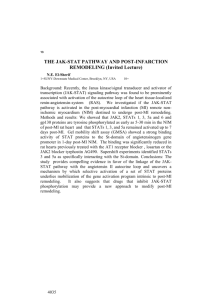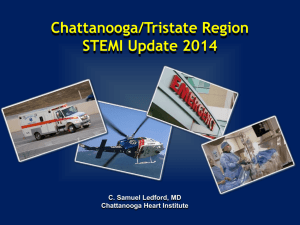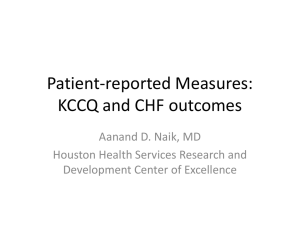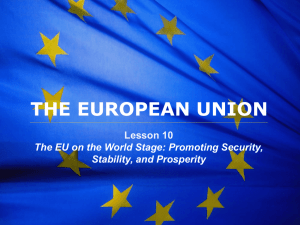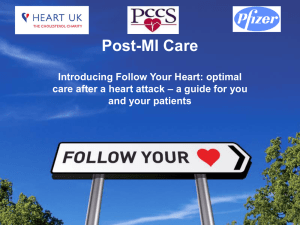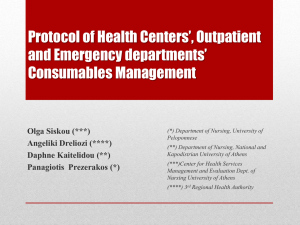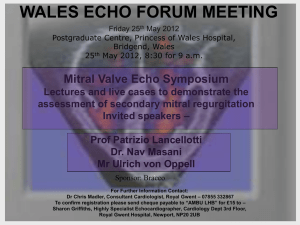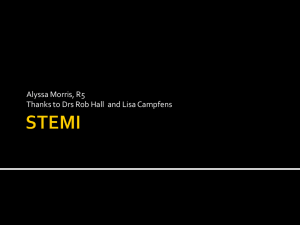Post MI Hyaluronic Acid to Prevent Remodeling
advertisement
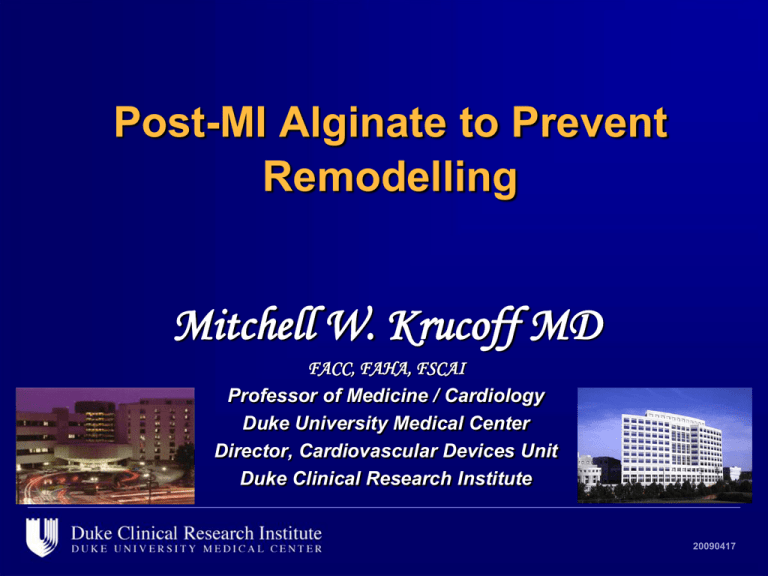
Post-MI Alginate to Prevent Remodelling Mitchell W. Krucoff MD FACC, FAHA, FSCAI Professor of Medicine / Cardiology Duke University Medical Center Director, Cardiovascular Devices Unit Duke Clinical Research Institute 20090417 Conflicts Research Grants & Consulting: Ikaria Medtronic Abbot Vascular 20090417 50 YEARS OF MORTALITY REDUCTION IN STEMI • • • • 1960-1978: 1978-1998: 1998-2004: 2005-2011: CCU observation: 20-25% Thrombolytics: 10-15% Direct PCI: <10% DTBT < 5% 30% 15% 1980 1990 2000 2010 3 STEMI SURVIVORS STILL HAVE BIG MI’S • Late presentations • Rural presentations • Reperfusion “injury” – Microvascular obstruction – Cellular toxicity Yellon D et al, N Engl J Med 2007;357:1121-35 4 ELDERLY: GROWING SURVIVOR POPULATION LITTLE KNOWLEDGE, MUCH MORBIDITY “Heart failure and pulmonary edema, complications along this spectrum of adverse occurrences, occur in more than half of patients 75 years and 65% of patients 85 years of age.” Circulation. 2007;115:2570-2589 5 POST-MI LV DILATATION 3 DECADES OF SIGNAL 6 END-SYSTOLIC VOLUME POST-MI: MORTALITY RISK Relative Risk 15 10 5 Normal End-Systolic Volume SD End-Systolic Volume, ml 1 50 100 150 200 White et al. Circulation. 1987;76:44 Baseline LVIDD and All Cause Mortality LVIDD Proportion Alive 1.0 0.9 Q1 0.8 Q2 Q3 0.7 P < 0.00001 Q4 0.6 0 4 8 Months 12 16 20 24 28 32 Wong M et al. J Am Coll Cardiol. 2002;40:970−975. 20090417 Therapies for Established Post-MI LV dilatation: Treating Established HF & Arrhythmias CHF meds: Afterload reducers Preload reducers Diuretics/nitrates CRT VADs Transplantation Cell therapy 20090417 Biomaterials to Reverse or Prevent LV Dilatation Rane AA et al, J. Am. Coll. Cardiol. 2011;58;2615-2629 UCSD 20090417 Biomaterials For MI Treatment: Post-MI LV remodelling LV restraints Epicardial patches Injectable therapies Rane AA et al, J. Am. Coll. Cardiol. 2011;58;2615-2629 20090417 Injectable Biomaterials Mechanisms: Cell delivery vehicles Bio-degradable: material degradation allowing for cell infiltration Inherent bioactivity Gelation with percutaneous delivery: Alginate Myocardial matrix Outcome objectives: Prevent remodelling Improve Efx Reduce MI size Increase neovascularization Rane AA et al, J. Am. Coll. Cardiol. 2011;58;2615-2629 20090417 Injectable Alginate: Seaweed derived polysaccharide Gelation scaffold in MI zone Enhance scar thickness Bioabsorbable material (>6 months) Pre-clinical: Porcine 1 week post-MI Rodent 1 week post-MI Prevent LV remodelling/dilatation/EDVI FIM Clinical IRA injection in acute STEMI Mukherjee R et al Ann Thorac Surg 2008;86:1268 –77 Landa N et al Circulation 2008;117:1388 –96 BioLineRx L. Safety and Feasibility of the Injectable BL-1040 Implant. Study NCT00557531, 2009. Available at: http:// www.ClinicalTrials.gov. Accessed March 19, 2012 20090417 Prevention of Remodeling of the Ventricle and Congestive Heart Failure After Acute Myocardial Infarction PRESERVATION 1: A Study of IK5001 Bioabsorbable Cardiac Matrix (BCM) After Large STEMI Mechanistic assumption: Calcium concentration in subacute MI zone will activate alginate cross-linking sufficient to provide structural resistance to post-MI LV remodelling over 6 months prior to bio-absorption Clinical Hypothesis: Sub-selective infusion of IK5001 BCM will prevent LV remodelling and associated functional debility and heart failure following “big” MIs. 16 PRESERVATION I: Operations • Study Co-PIs: Sunil Rao MD, Uwe Zeimer MD • Study Chair: Mitchell Krucoff MD • DSMC Chair: E. Magnus Ohman MD • Study Sponsor: Ikaria • Data Center: Duke Clinical Research Institute (DCRI) • Echo Core Lab: DCRI (Pam Douglas MD) • Angio Core Lab: Perfuse (Michael Gibson MD) PRESERVATION I: Design • Multicenter, 2:1 randomized, double blind, placebo-controlled • 306 “Big MI” STEMI patients • 60 sites: EU, Australia, Canada, Middle East, USA • Dedicated 3-7 day post-MI deployment procedure: – 4 cc sub-selective IRA-IC IK5001 BCM infusion over 30 seconds • Mechanistic primary endpoint: – LV End-diastolic dimension index by 3-D echo • Secondary endpoint: new onset CHF IN-HOSPITAL PROTOCOL “Big MI” criteria Consent Successful Index PCI For STEMI Day 0 Screening Consent SPECT/MRI Echo, ECG 6 min walk KCCQ NYHA class NT-Pro-BNP Labs, UA Deployment Procedure (Index visit) Day 2-5 Coronary angio Randomization 24-hr ECG CKMB PK sample PostDeployment Coronary angio 24-hr ECG Echo Labs incl. CKMB Randomize 3 second sub-selective IK5001 BCM deployment into IRA Discharge Clinical outcomes Urinalysis PK sample POST-DISCHARGE PROTOCOL Primary Endpoint 1-month ±3d 3 months ± 7d 6 months ± 14d 12 months ± 14d Echo ECG KCCQ 6-min walk NYHA Class NT-Pro-BNP Labs PK Sample Echo ECG KCCQ 6-min walk NYHA Class NT-Pro-BNP Labs PK Sample Echo ECG KCCQ 6-min walk NYHA Class NT-Pro-BNP Labs Healthcare Utilization and Clinical outcomes Echo KCCQ 6-min walk NYHA Class Healthcare Utilization and Clinical outcomes Key Inclusion Criteria 3-5 day “Big” MI after Successful Acute STEMI PCI • “Big” MI defined as: – Peak cardiac enzyme value within 48 hours of symptom onset as follows: • Creatine kinase MB fraction (CK-MB) > 30x the upper limit of normal OR • Troponin I > 200x upper limit of normal OR • Troponin T > 60x the upper limit of normal – AND at least 1 of the following 3 criteria: • Delayed presentation with PCI > 6 hours from onset of symptoms • Significant new Q waves in ≥ 2 anterior leads or anterior ST segment elevation of at least 3 mm persistent at 24 hours after PCI • New onset of congestive heart failure (CHF) (Killip class 3-4) or cardiogenic shock persistent at 24 hours after PCI – AND at least 1 of the following 2 criteria: • MI ≥ 20% by Single Photon Emission Computed Tomography scan (SPECT) or cardiac MRI with defect in the appropriate distribution • Ejection fraction ≤ 35% at baseline imaging assessment with wall motion abnormality in the appropriate distribution Conclusion: Injectables To Prevent LV Dilatation Many challenges remain Stiffness vs. elasticity Optimal degradation rate Inflammatory response Stand-alone vs. cell/compound loaded Timing & modality of administration Endpoint selection: Imaging Ventricular twist models Electro-mechanical models PRESERVATION I: •First RCT in human subjects •Challenges: • Timely “Big” MI definition • Optimal imaging F/U • Assessment of HF prevention Human studies 20090417 Post-MI Alginate to Prevent Remodelling Mitchell W. Krucoff MD FACC, FAHA, FSCAI Professor of Medicine / Cardiology Duke University Medical Center Director, Cardiovascular Devices Unit Duke Clinical Research Institute 20090417
